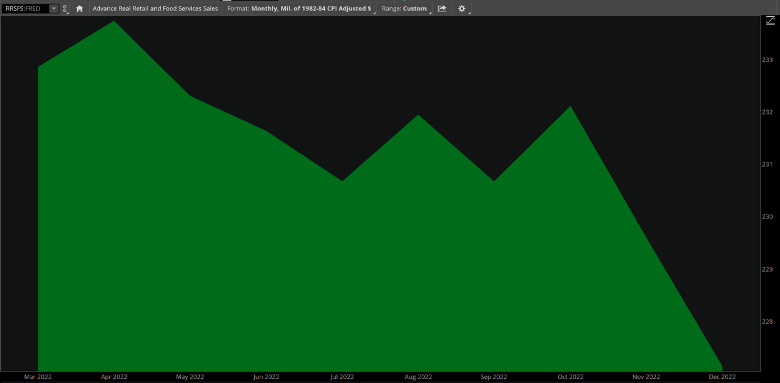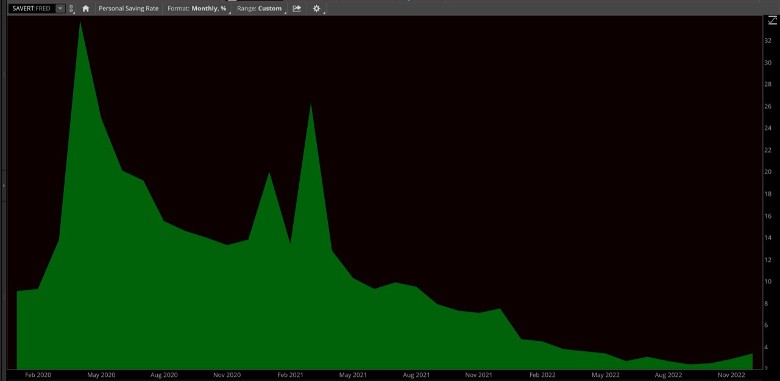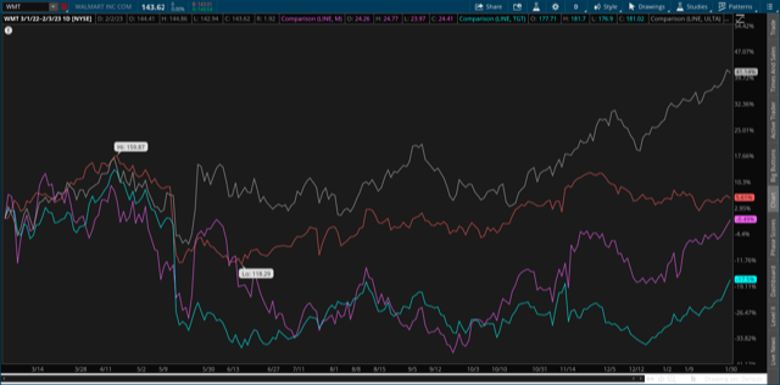Few things shape economic perceptions more than the prices people pay daily at the grocery store, shopping center, or gas pump. And as 2022 wrapped up, the retail sector once again likely reflected how consumers grasp sudden shocks to their household finances.
Based on how December U.S. Retail Sales looked, the answer is likely not terribly well. As inflation shot up in 2022, every retail category but grocery, building materials and sporting goods took a tumble.
This isn’t the first recent holiday season to test retailers. In 2020, it was a global health crisis that reset workplaces, personal savings, and available goods. In 2021, another burst of COVID-19 hit in December and sales dropped below expectations. And at the end of 2022, it was 10 months of spiraling inflation that peaked at 40-year highs after an extended near-zero rate environment during the two previous years.
So we know the big headlines. How will retailers see the picture as they report Q4 results in the coming weeks? Did consumers close their wallets overall, or did they simply divert that spending toward travel, dining out and other “experiences” that were so limited during the worst days of the pandemic?
Remember—what happens in households often portends what’s next for the global economy. After all, consumer spending comprises roughly 70% of Gross Domestic Product.
For now, let’s look at trends that likely shaped the final quarter and what could be revealed in Q4 results starting mid-month:
- Black Friday got bleaker: As of last week,U.S. retail sales figures had fallen in three of the last four months. But December was the real eye-opener (see Figure 1) because many consumers basically froze their spending in the retail economy that had been so robust since the pandemic. You probably know what happened to spending on personal and business technology and to companies like Apple (NASDAQ:AAPL) and Microsoft (NASDAQ:MSFT). We’ll get fresh retail sales numbers for January on February 15.
- Inflation’s pinch seems far from over:On February 3, January’s employment figures managed to pin the market’s ears back in more ways than one. Retailers may have cheered data indicating worker demand remains strong—providing at least some evidence that customers still have money to spend. But retailers also feel wage pressure. Then there’s the question of how much disposable income is really out there. In December, a study from PYMNTS and LendingClub (NYSE:LC) reported that 63% of Americans were living “paycheck to paycheck,” with a notable increase among consumers making more than $100,000 per year. If hiring and wage levels finally start to recede, we may see staffing and store count changes at some retailers and more extreme decisions at others, such as long-troubled Bed Bath & Beyond (NASDAQ:BBBY), which announced plans to shutter nearly 90 stores just last week.
- Revolving credit rates keep rising: Academics and economists will likely be studying—and debating—the effects of COVID-19 stimulus programs for years to come. But consider what federal aid did for household savings (see Figure 2) and how quickly that cushion lost stuffing when aid began to shut off at midyear 2021 and 40-year inflation began to settle in. When prices go up, many households make do with credit card spending, and Bankrate reports the average credit card rate is up 4 percentage points since last March to an average 20%. And though credit delinquencies are still at historic lows, TransUnion (NYSE:TRU) thinks that serious credit card delinquencies may rise this year to their highest levels since 2010.


Wrapping up a worrisome year
Will there be many earnings surprises in the upcoming Q4 retail sector numbers? We’ll have to see, but revised guidance in retail leading up to the holiday shopping season already made plenty of news this year.
If you read our Q3 Retail Earnings Preview, we talked about a pullback in once-heavy holiday hiring as retailers continued to wrestle with wholesale prices, shipping costs, and continued supply chain headaches affecting what would finally make it to the shelves.
Research shows it was a fairly interesting quarter for certain retail sub-sectors as well.
As of late January, FactSet estimated the consumer discretionary sector had the second-largest year-over-year earnings decline across all 11 S&P 500® industry sectors at –20.6%. The research firm said six of the 10 industries in the sector are expected to see a year-over-year decrease in earnings, with four of those six industries down more than 10%:
- Internet and direct marketing retail (–84%)
- Multiline retail (–30%)
- Household durables (–13%)
- Textiles, apparel, and luxury goods (–11%)
However, there’s a big caveat in that first bullet above. Its name is Amazon (NASDAQ:AMZN). AMZN’s Q4 earnings picture came in less than rosy on Friday, and FactSet said it was the “largest contributor to the earnings decline for consumer discretionary” as a whole. Without AMZN, the full sector’s year-over-year Q4 earnings growth would be 16.1%.
So, it’s all about digging deeper. As you listen to various retailers’ earnings calls, here are a few questions to keep in mind:
- As inflation and requisite rate hikes take a bigger bite out of both lower- and higher-income paychecks for a longer period of time, how will that affect retailers serving customers with more discretionary income, such as Macy’s (M) or Nordstrom (NYSE:JWN), or generally less, such as Dollar Tree (NASDAQ:DLTR) or Walmart (NYSE:WMT)?
- Margins were squeezed throughout 2022—what was the final Q4 impact and are they likely to improve this year?
- Where do retail supply chain challenges stand right now—from securing merchandise to the costs of last-mile delivery—and will these strategies change?
- Some retailers sprung eye-opening policy changes on consumers this holiday season, including the return of restocking fees, and stricter return policies. How did consumers react, and will such policies continue?
- What retail technology investments paid off for companies by year-end, and where might they be expanded?
- If the job market really does slow down in 2023, how will stores pivot in hiring practices and brick-and-mortar strategies?

Here’s a quick look at what to watch for as the following retail leaders report.
Walmart (WMT)
Expected report date: Tuesday, February 21, before the open
- Expected Q4 EPS (analysts’ consensus): $1.50
- Year-ago EPS: $1.53
- Expected year-over-year EPS change: –1.96%
- Expected Q4 revenue (analysts’ consensus): $159.36 billion
- Year-ago revenue: $152.87 billion
What to watch: Consumers wrestling with higher food and gas prices managed to show WMT loyalty this year within their Sam’s Club warehouse operation. After seeing sharp growth in membership and sales from the pandemic through today, Walmart announced last month it plans to open 30 new stores in “high-growth suburban areas” where the Sam’s Club locations are few and far between. It’s the first time WMT has launched a major Sam’s expansion in more than a decade. It’s not just about Sam’s, though. Competing warehouse retailers Costco (NASDAQ:COST) and BJ’s Wholesale Club (BJ) also gained significant membership after gasoline prices spiked last year.
Home Depot and Lowe’s
Home Depot (NYSE:HD) expected report date: Tuesday, February 21, before the open
- Expected Q4 EPS (analysts’ consensus): $2.24
- Year-ago EPS: $1.78
- Expected year-over-year EPS change: +2.1%
- Expected Q4 revenue (analysts’ average estimate): $36.01 billion
- Year-ago revenue: $35.72 billion
Lowe’s Companies (NYSE:LOW) expected report date: Wednesday, March 1, before the open
- Expected Q4 EPS (analysts’ consensus): $3.28
- Year-ago EPS: $3.21
- Expected year-over-year EPS change: +25.8%
- Expected Q4 revenue (analysts’ average estimate): $22.78 billion
- Year-ago revenue: $21.34 billion
What to watch: Mortgage rates spiraled in 2022, and as of late January, existing home sales were down for the 11th straight month. Regardless of where the housing picture goes in 2023, the rivalry is getting more interesting between the nation’s two largest home improvement chains. Barron’s recently reported that Lowe’s is trading at “a discount to its larger rival and the S&P 500,” adding that Lowe’s has an operating profit margin of just under 13% compared to HD’s 15% with plans to raise that number to 14.5% “by around 2026.”
Target (TGT)
Expected report date: Tuesday, February 28, before the open
- Expected Q4 EPS (analysts’ consensus): $1.39
- Year-ago EPS: $3.19
- Expected year-over-year EPS change: –56.4%%
- Expected Q4 revenue (analysts’ consensus): $30.7 billion
- Year-ago revenue: $31 billion
What to watch: The upscale discounter was among the first major retailers in 2022 to signal trouble, reporting inventory problems in Q2. In its Q3 report, TGT cut Q4 earnings guidance and said it expects its first comparable sales decline in five years. TGT became the poster child for pandemic-era overstocking and paid for it. Most analysts don’t think the situation has improved much.
Macy’s (M)
Expected report date: Early March
- Expected Q4 EPS (analysts’ consensus): $1.57
- Year-ago EPS: $2.45
- Expected year-over-year EPS change: –35.9%
- Expected Q4 revenue (analysts’ consensus): $8.25 billion
- Year-ago revenue: $8.66 billion
What to watch: In early January, M issued guidance that its revenues would be at the lower end of guidance, but CEO Jeff Gennette believes the consumer “will continue to be pressured in 2023, particularly in the first half.” As for the recent holiday season, he said “the lulls of the nonpeak holiday weeks were deeper than anticipated,” foreshadowing the disappointing U.S. retail sales report issued January 18.
Nordstrom (JWN)
Expected report date: Thursday, March 2, after the close
- Expected Q4 EPS (analysts’ consensus): $0.71
- Year-ago EPS: $1.23
- Expected year-over-year EPS change: –42.3%
- Expected Q4 revenue (analysts’ consensus): $4.33 billion
- Year-ago revenue: $4.49 billion
What to watch: GameStop (NYSE:GME) Chairman and meme stock investor Ryan Cohen turned his attention to the Seattle-based department store retailer Nordstrom after it cut its full-year guidance due to the slow holiday season. On Friday, JWN shares rose more than 20% after The Wall Street Journal reported Cohen took a “major stake” in the department store company.
Ulta Beauty (NASDAQ:ULTA)
Expected report date: Thursday, March 2, before open
- Expected Q4 EPS (analysts’ average estimate): $5.57
- Year-ago EPS: $5.41
- Expected year-over-year EPS change: +3.0%
- Expected Q4 revenue (analysts’ average estimate): $3.01 billion
- Year-ago revenue: $2.73 billion
What to watch: Ulta, a hair-and-beauty chain, stood out last year. As workers head back to the office, into job interviews, back to business travel, or simply out on the town, beauty has been a sturdy product and service category across all specialty and department stores, according to analysts. And this year’s Q4 holiday party season was probably the best in years. However, early in January, Barron’s reported that Wells Fargo (NYSE:WFC) downgraded ULTA to underweight from equal weight because it believes ULTA’s operating margins could fall back to pre-COVID-19 levels now that the economy is mostly reopened.
We’ll see if the party continues in 2023.
